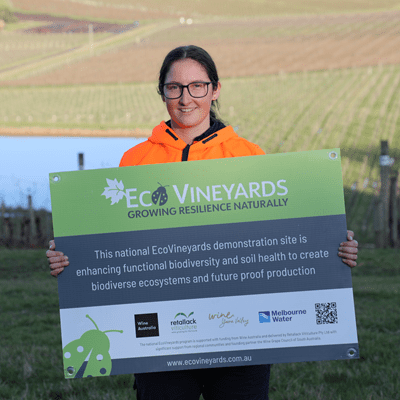Tell us in a few sentences about your experience as a viticulturist, how did you arrive here?
I have been working with DeBortoli for a little over two years after completing a Bachelor of Agriculture at the University of Melbourne. I gained an interest in viticulture while working on my uncle’s vineyard during my gap year and throughout my agriculture course.
Over the past 12 months I have become more involved in sustainability projects and have gained a keen interest in learning about farming practices that can benefit the environment as well as improve our vineyards.
Why did you decide to apply to be an EcoGrower, was there something specific that influenced your decision and/or had you attended a previous EcoVineyards session?
We decided to apply to be an EcoGrower to enhance the biodiversity of our vineyards. We have tried similar things before and have had mixed results. We are always striving to learn more about sustainable vineyard practices and ways of creating a more balanced ecosystem and think that undertaking a project like this can be greatly advantageous to us and our community.
Has there been a defining moment or catalyst for you to move towards more ecologically driven viticultural practices?
There’s not necessarily a catalyst or defining moment, just an understanding that if nature provides an alternative to achieve a sustainable outcome, it will always be beneficial economically and environmentally.
Can you provide a brief overview of your project ideas, and what you wish to achieve over the 3 years and why is this important to you?
We have chosen four different weeds that occur in different areas of our vineyard that play a significant role in water and nutrient competition and interfere with the wine-making processes. These are mustard weed, wild radish, couch, and wild rocket. We know that the above species from the brassicaceae family have no mycorrhizal associations, and that plants from this family repel nematodes. These are aspects we would like to bring back to our vineyards. For all these weeds we have found that they are allelopathic.
We would like to focus on plant selections in mid-rows and under-vine with some or all the following characteristics:
Flowering plants to encourage beneficial insects to come back to the vineyard.
- Short in stature to reduce/remove the need for mowing and therefore reduce the number of tractor passes necessary;
- No fragrance that will interfere with the wine-making process; and
- Preferably plant species derived from a similar location to the root stocks of our vines (Texan hill-country).
We also think it would be a great opportunity to trial plants with the same mycorrhizal hyphae as the vines, and those different to the vines to determine what, if any, difference there may be.
We would like to focus our efforts on the following areas using ground covers:
- Finding competitive plant species to reduce/eliminate mustard weed, wild radish, couch grass and wild rocket from vineyards to reduce competition with vines and beneficial ground covers.
- Increase the soil microorganisms, specifically nematodes
- Increase vine/vineyard soil mycorrhizal associations.
Are you just starting to learn, or have you been enhancing biodiversity on your property and is this an extension of what you are currently doing?
While I am just beginning to learn practical sustainability methods, DeBortoli has been aiming for greater understanding of biodiversity, local natural environments, and sustainability for many years now. This project will be an extension of some of the things we have already looked at, with the hopes of having a deeper understanding of under-vine and mid-row plantings.

